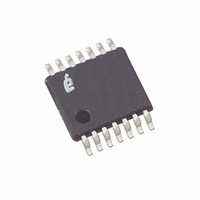X40626V14-4.5AT1 Intersil, X40626V14-4.5AT1 Datasheet - Page 8

X40626V14-4.5AT1
Manufacturer Part Number
X40626V14-4.5AT1
Description
IC SUPERVISOR CPU DUAL 14-TSSOP
Manufacturer
Intersil
Type
Multi-Voltage Supervisorr
Datasheet
1.X40626S14.pdf
(22 pages)
Specifications of X40626V14-4.5AT1
Number Of Voltages Monitored
2
Output
Open Drain or Open Collector
Reset
Active Low
Reset Timeout
100 ms Minimum
Voltage - Threshold
2.93V, 4.63V
Operating Temperature
0°C ~ 70°C
Mounting Type
Surface Mount
Package / Case
14-TSSOP
Lead Free Status / RoHS Status
Contains lead / RoHS non-compliant
Available stocks
Company
Part Number
Manufacturer
Quantity
Price
Company:
Part Number:
X40626V14-4.5AT1
Manufacturer:
VISHAY
Quantity:
3 123
Figure 5. Valid Data Changes on the SDA Bus
Serial Start Condition
All commands are preceded by the start condition,
which is a HIGH to LOW transition of SDA when SCL
is HIGH. The device continuously monitors the SDA
and SCL lines for the start condition and will not
respond to any command until this condition has been
met. See Figure 6.
Figure 6. Valid Start and Stop Conditions
Serial Acknowledge
Acknowledge is a software convention used to indi-
cate successful data transfer. The transmitting device,
either master or slave, will release the bus after trans-
mitting eight bits. During the ninth clock cycle, the
receiver will pull the SDA line LOW to acknowledge
that it received the eight bits of data. Refer to Figure 7.
The device will respond with an acknowledge after
recognition of a start condition and if the correct
Device Identifier and Select bits are contained in the
Slave Address Byte. If a write operation is selected,
the device will respond with an acknowledge after the
receipt of each subsequent eight bit word. The device
will acknowledge all incoming data and address bytes,
except for the Slave Address Byte when the Device
Identifier and/or Select bits are incorrect.
SDA
SCL
SCL
SDA
8
Data Stable
Start
X40626
Data Change
Serial Stop Condition
All communications must be terminated by a stop con-
dition, which is a LOW to HIGH transition of SDA when
SCL is HIGH. The stop condition is also used to place
the device into the Standby power mode after a read
sequence. A stop condition can only be issued after the
transmitting device has released the bus. See Figure 6.
In the read mode, the device will transmit eight bits of
data, release the SDA line, then monitor the line for an
acknowledge. If an acknowledge is detected and no
stop condition is generated by the master, the device
will continue to transmit data. The device will terminate
further data transmissions if an acknowledge is not
detected. The master must then issue a stop condition
to return the device to Standby mode and place the
device into a known state.
Data Stable
Stop
March 28, 2005
FN8119.0













